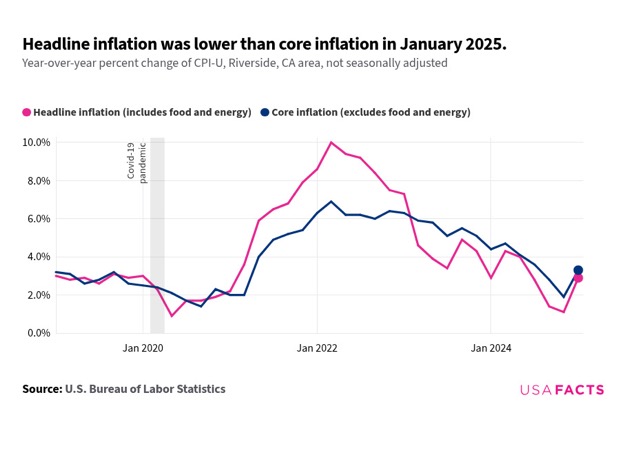Regional Inflation
RIVERSIDE (CNS) – Inflation throughout the Riverside metropolitan area increased nearly 2% over the previous two months, pushed higher by rising costs across most sectors of the regional economy, according to data released by the U.S. Bureau of Labor Statistics.
The agency’s bimonthly report, posted on Wednesday, covering northwestern Riverside County, as well as the cities of Ontario and San Bernardino, indicated that the Inland Empire’s Consumer Price Index was up 1.8%.
BLS officials said that shelter costs, or property rents, were among the main drivers of price hikes in the months of December and January, climbing an estimated 2%.
Food costs weren’t far behind at 1.6%, “with higher prices in four of the six major grocery store food groups,” according to the agency.
The energy sector showed a modest uptick of .7% during the two-month period, data showed.
Trending lower were prices categorized as miscellaneous “goods and services,” which dropped 2%, while education costs fell by .6%, according to figures.
Longer term, the regional CPI was 2.9% higher over the previous 12 months, led by increasing pocketbook pressure for rents at 4.2% and grocery prices at 4%, federal officials said.
Energy costs were down 2.3% over the yearlong period, with prices on goods and services lower by 6.8% in the year-over-year CPI.
The report showed inflation was up .5% nationwide last month, and 3% from January 2024 to January 2025.
The current rate of inflation reflects the elevated price trajectory impacting most sectors of the economy.
Accelerating consumer price hikes had been blamed by the Biden administration on the war in Ukraine and consequent energy supply disruptions, but critics pointed to the administration’s restrictive domestic energy policies, as well as excessive spending, including the flood of dollars contained in relief packages, as root causes.
The national debt is $36.2 trillion, according to the U.S. Treasury Department. Estimated annualized interest rate payments on the country’s debt passed the $1 trillion mark in November 2023, according to Bloomberg News. That same month, Moody’s Investors Service lowered its outlook on the U.S.’s credit rating from “stable” to “negative.”
The Federal Reserve’s Open Market Committee increased its benchmark, or target, lending rate in the spring of 2022 to soak up excess liquidity, though the FOMC stopped hikes in the fall of 2023, and last year initiated gradual cuts, bringing the rate down to roughly 4.5% on the belief that inflation had been tamed.

For More Economy News Visit www.zapinin.com/economy

